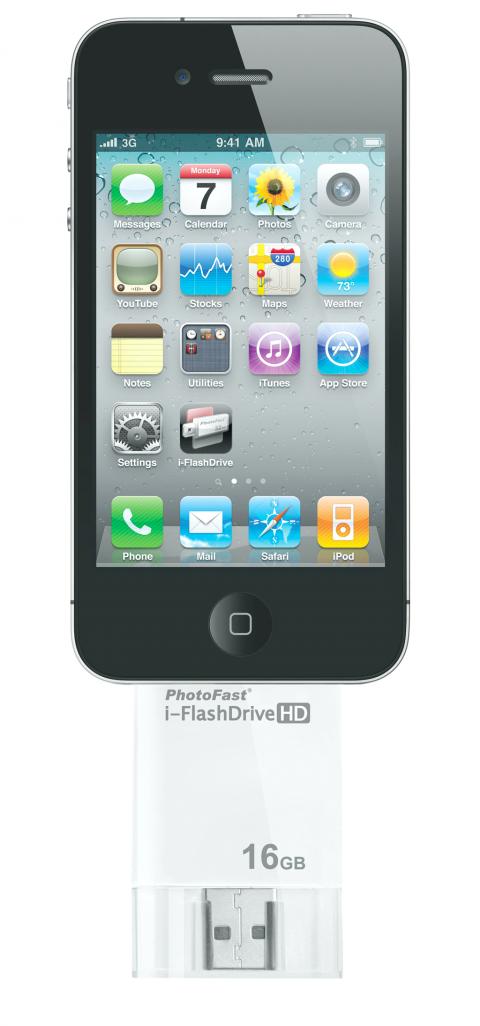If you have an iPhone or an iPad and want to transfer files onto your device from a computer the old-fashioned way, then PhotoFast might have just the thing for you.
The Taipei company makes i-FlashDrive HD, a USB thumb drive with an extra plug that connects directly to your “iDevices.”
As a standalone unit, the i-FlashDrive is simply a tiny, portable hard drive, offered in capacities of 8, 16, 32 and 64 gigabytes. This square-shaped dongle, with a USB plug on one end and an Apple dock connector on the other, easily fits into your jeans mini-pocket.

photos courtesy of photofast
But the main selling point here is that you have a simple transfer depot between your computer and iDevice. The idea behind i-FlashDrive is that you load it with files from your computer, so you can plug it into your iPhone or iPad and move your stuff there.
This allows you a quick and dirty way to do things like plop a video or music album onto your phone without having to plug your device into a computer and sync through iTunes.
Another feature of the i-FlashDrive is that it can also be used to transfer files between iOS devices, making it a one-of-a-kind product, at least for now.

photos courtesy of photofast
But there are a few big caveats to consider. While it’s nice to have a “plug and go” method of transferring files between an iPhone and iPad, much of that usefulness is negated if you already use iCloud, which wirelessly syncs photos, music and documents across your devices.
And the files don’t instantly appear in your iPhone or iPad — you can only access them through the iFlashDrive app, which you have to download and install from the app store.
The app is free and straightforward to use, but points to a glaring limitation. You can copy that Jay Chou (周杰倫) album onto your phone, but you can only listen to it in the i-FlashDrive app. The files don’t become part of the music library on your phone, which means you can’t add it to your favorite playlists. The same goes for videos — they can only be viewed within the app.
This is not necessarily a bad thing, as the i-FlashDrive app has a built-in music and video player that gets the job done. (Also, the blame for the shortcoming doesn’t rest with PhotoFast, but rather Apple’s strict rules on writing software for iOS.) But I can imagine eventually missing Apple’s integrated iOS apps after a while.
Not all files have this limitation. From within the i-FlashDrive app, you can copy photos into your photo library, and you can open Word documents and PDFs in other compatible apps like Goodreader or Evernote.
Getting files from your computer to your iDevice using i-FlashDrive is relatively simple, but this is not the case in the other direction.
The only files that you can move from your iPhone or iPad to this USB thumb drive are photos, and you have to go through the process of copying them into a folder that can only be accessed from within the i-FlashDrive app. Music, videos and most other documents that you sync via iTunes are a no-go. (Again, this limitation has to do more with Apple’s guidelines for apps than engineering finesse on PhotoFast’s part.)
On the plus side, the i-FlashDrive app is set up to directly connect to a Dropbox account. This works nicely, except that you can’t copy files directly on to the i-FlashDrive from Dropbox. Instead, you’re left with a roundabout route, copying from Dropbox to your local folder on the i-FlashDrive app, and then copying the file over to the plug-in drive.
The i-FlashDrive is a novel product that will likely appeal most to those who haven’t quite embraced “the cloud” and prefer to move and transfer files themselves, a la the old days of file management on Windows computers.
And the price of this novelty isn’t cheap. The 8GB drive costs NT$1,990, while the 64GB model is NT$8,690.
But if you can live with i-FlashDrive’s walled garden solution — where you access and manage all of your files through a single app — then this could be the ultimate USB thumb drive for iPhone and iPad users.
The i-FlashDrive is available at all major electronics retailers and through photofast.tw.

Next week, candidates will officially register to run for chair of the Chinese Nationalist Party (KMT). By the end of Friday, we will know who has registered for the Oct. 18 election. The number of declared candidates has been fluctuating daily. Some candidates registering may be disqualified, so the final list may be in flux for weeks. The list of likely candidates ranges from deep blue to deeper blue to deepest blue, bordering on red (pro-Chinese Communist Party, CCP). Unless current Chairman Eric Chu (朱立倫) can be convinced to run for re-election, the party looks likely to shift towards more hardline

Last week the story of the giant illegal crater dug in Kaohsiung’s Meinong District (美濃) emerged into the public consciousness. The site was used for sand and gravel extraction, and then filled with construction waste. Locals referred to it sardonically as the “Meinong Grand Canyon,” according to media reports, because it was 2 hectares in length and 10 meters deep. The land involved included both state-owned and local farm land. Local media said that the site had generated NT$300 million in profits, against fines of a few million and the loss of some excavators. OFFICIAL CORRUPTION? The site had been seized

Sept. 15 to Sept. 21 A Bhutanese princess caught at Taoyuan Airport with 22 rhino horns — worth about NT$31 million today — might have been just another curious front-page story. But the Sept. 17, 1993 incident came at a sensitive moment. Taiwan, dubbed “Die-wan” by the British conservationist group Environmental Investigation Agency (EIA), was under international fire for being a major hub for rhino horn. Just 10 days earlier, US secretary of the interior Bruce Babbitt had recommended sanctions against Taiwan for its “failure to end its participation in rhinoceros horn trade.” Even though Taiwan had restricted imports since 1985 and enacted

Enter the Dragon 13 will bring Taiwan’s first taste of Dirty Boxing Sunday at Taipei Gymnasium, one highlight of a mixed-rules card blending new formats with traditional MMA. The undercard starts at 10:30am, with the main card beginning at 4pm. Tickets are NT$1,200. Dirty Boxing is a US-born ruleset popularized by fighters Mike Perry and Jon Jones as an alternative to boxing. The format has gained traction overseas, with its inaugural championship streamed free to millions on YouTube, Facebook and Instagram. Taiwan’s version allows punches and elbows with clinch striking, but bans kicks, knees and takedowns. The rules are stricter than the